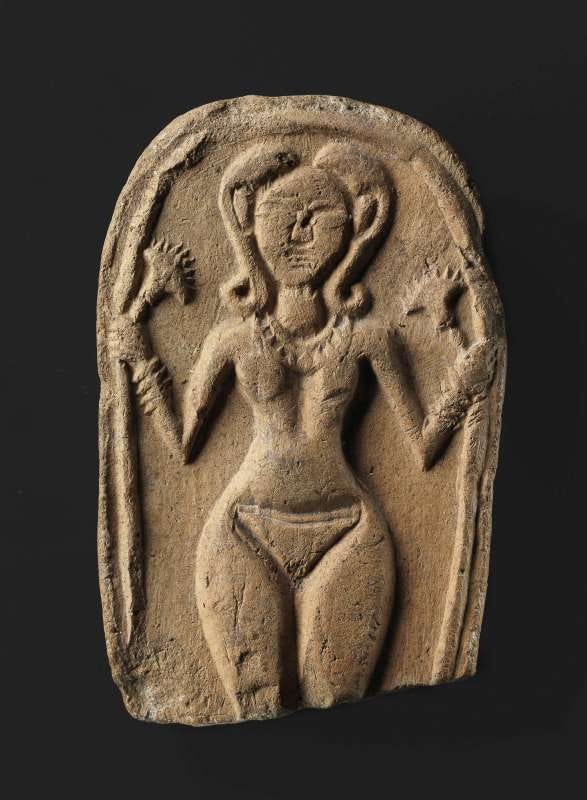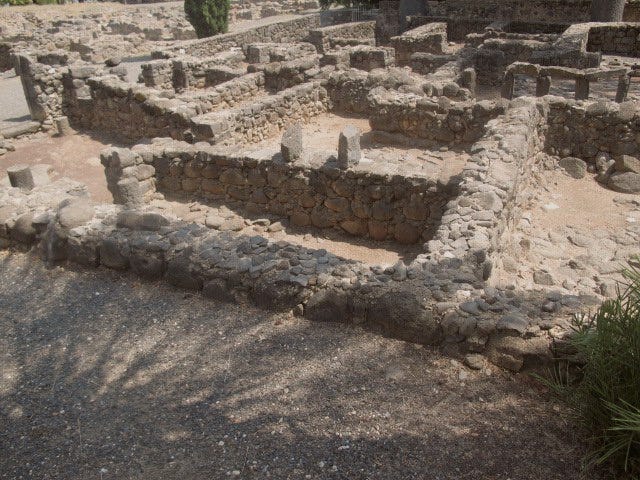
Listen via audio:
Nestled in the belly of the land known as the Fertile Crescent, Palestine is one of the oldest human settlements in the world. There is archaeological evidence for an early nomadic hunter-gatherer community living there as early as 10,000 BC. One of the oldest artefacts in the region comes from a cave near Bethlehem in the modern-day West Bank, otherwise called the Occupied Palestinian Territories. Known as The Lovers, it is the earliest known depiction of a couple making love and is about 11,000 years old (pictured below). I was entirely enraptured when I first came across it at the British Museum in my early twenties.
Following the first nomadic-pastoral communities, permanent settlements were then established in the early Bronze Age. And because of its strategic location between Mesopotamia and the Kingdoms of Arabia and Egypt, Palestine became a significant trading hub in the ancient world.
In the Bronze Age, Palestine was known as Canaan. It encompassed what is currently left of Palestine - notably Gaza and the West Bank - along with modern-day Israel, Jordan and the southern parts of Lebanon and Syria. It was a Semitic-speaking civilisation dating to the 2nd millennium BC.

The Biblical records of the Canaanite religion are negative, painting the indigenous people of Canaan as savage and barbarous. Where have we heard this before? Is this not a repeated theme in history whereby an invading power dehumanises the people of the land it is invading to justify its occupation? The Roman Empire were famous for it.
The term “Celts”, for instance, was used as a derogatory term by the Romans to describe the native peoples of the British Isles who were seen as uncivilised and therefore deserving of subjugation.
This was no different in Bronze Age Canaan. The indigenous peoples became known as the Philistines. Interestingly, calling someone a ‘philistine’ now is synonymous with being uncultured, ignorant and, essentially, a barbarian.
Archaeologists usually refer to the peoples of this region as Canaanites until about 1200 BC. They then call them Phoenicians in the Iron Age.

The ancient Canaanites venerated a Great Mother Goddess known as Ashtareh. She was the Creator Goddess of the Canaanite pantheon, and her consort was the God El, who often took the form of Baal.
Baal was also the term used to refer to the God who was Ashtareh’s consort, and was the Semitic name for Pan the Greek god of the wild. In myth, when he died he became the constellation of Capricorn, the Goat in the heavens. Phoenician colonies in Spain introduced the term “Baal” to Ireland, and it later became used to denote the Irish God Bel, “Lord of Beltain.”1
The traditions of the Canaanites were later taken over and became the cult of Yahweh, who replaced the earlier Baal. At first, Ashtareh was venerated alongside Yahweh, her consort. But eventually - primarily through the efforts of the prophet Samuel - the worship of the Goddess was banned.
However, she was continually re-introduced by the Phoenicians, particularly Phoenician queens from neighbouring modern-day Lebanon, until she was finally masculinised and demonised by Christian writers.
In Canaanite myth, a story tells of the Priestesses of Ashtareh burying the God of the Hunt, Baal-Hadad, in a bog. He lay there for seven years, after which the priestesses resurrected him. The bog may well have been understood as the womb of the earth. And this is reminiscent of the death mysteries and initiatory rites of the ancient world, such as those found in the Eleusinian Mysteries, with Persephone’s descent into the Underworld, and the Mystery Cult of Dionysus and his rites of renewal through symbolic dismemberment.
Ashtareh is one of the oldest forms of the Goddess in the Middle East. She is synonymous with Crete’s Demeter, Cyprus’ Aphrodite and Egypt’s Hathor.
She was the same Mother Goddess worshipped by pre and Indo-European cultures of the Neolithic, and perhaps even represented by the Goddess figures of the Palaeolithic caves. She was the regenerative force that preserved life and there was a time when kings could not rule without her permission.
This is reminiscent of the hieros gamos rites and the stories of the Arthurian grail legends that tell of ancient rituals in which a newly appointed king consorted with a high priestess who represented the land as a means of preserving a sacred contract between the people and the natural world. The king would “wed” the land and proclaim his allegiance to her wellbeing.
Ashtareh is known in the Bible as Asherah, the Goddess worshipped by Solomon (1 Kings 11:15). And in Milton’s Paradise Lost he calls her “queen of heaven, with crescent horns; / To whose bright image nightly by the moon / Sidonian virgins paid their vows and songs” (1.439-441).
In the Semitic lands she was the Heavenly Goddess, ruling over the spirits of the dead who were understood to be the stars in the sky. And so one of her epithets was “Queen of Stars” - in fact her name is where we get the term “astrology” from! Joseph Campbell famously called the study of stars the basis of all intellectual culture.
When we really look back at this ancient religion, we can see a prototype of the virgin Mary… Once, to the Arabs she was Athtar, “Venus in the Morning” and in Canaan, she was the Mother of the Gods (mother of all baalim - gods) They called her Qaniyatu elima, “She Who Gives Birth to the Gods”. Her Semitic name was Asherah, perhaps from the Old Farsi asha, meaning universal law, a law of matriarchs like the Roman ius naturale. And in the Old Testament, the word Asherah is translated as “grove”, which represented her genitals. In matriarchal periods, she was worshipped by her priests and priestesses alike in actual groves. These initial tree-temples were eventually cut down by patriarchal reformers.

In 2016, women led a march for peace from the north of Israel to Jerusalem. Here is a song by Yael Deckelbaum combining a recording of Leymah, sampled from a youtube video in which she sent her blessings to the movement.
RESOURCES:
From Black Land to Fifth Sun: The Science of Sacred Sites, Brian Fagan - particularly the chapter on Jericho
When God was a Woman, Merlin Stone
Did God Have a Wife?: Archaeology and Folk Religion in Ancient Israel, William G Denver
The Bible's Buried Secrets - three-part series on the BBC
Barbara G. Walker, Women’s Encyclopaedia of Myths and Secrets, p. 48






I got so much from this, thank you. So wonderful to examine the story of Phoenician culture from the birthplace of ancient Palestine.